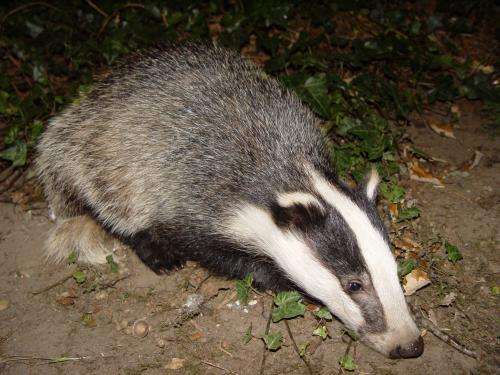New research finds that cattle and badgers with TB rarely meet

Direct contact between badgers and cattle is rare, suggesting that it may also be rare for bovine tuberculosis (TB) to be passed on through the two species meeting each other on pasture, new research by the Royal Veterinary College and the Food and Environment Research Agency published in the journal Epidemiology and Infection (Cambridge University Press) reveals.
Researchers investigated direct and indirect interactions between badgers and cattle by fitting automated high-tech proximity loggers to animals and placing base stations at badger latrines located on pasture, in an area of south-west England with a high-density badger population, over a period of 12-months.
Direct interactions (within 1.4 metres) between badgers and cows at pasture were very rare, with only four out of over 500,000 animal-to-animal contacts recorded between the two species.
Indirect interactions (visits to badger latrines) were far more frequent than direct contacts, with 400 visits by badgers and 1700 visits by cattle recorded. This suggests that indirect contacts might be more important than direct in terms of disease transmission at pasture.
During the study half of the badgers tested positive for TB, however the infection status of individual badgers did not affect the frequency or duration of their visits to latrines located on pasture grazed by cattle.
Bovine tuberculosis caused by infection with Mycobacterium bovis is endemic in cattle in parts of England and Wales and its control is hindered by the presence of infection in the European badger. While M. bovis is clearly transmitted between cattle and badgers, it is has not previously been known where, when or how often transmission occurs.
Dr Julian Drewe from the Royal Veterinary College who led the study, said: "Our findings reveal that direct contacts between badgers and cattle at pasture are surprisingly rare, despite ample opportunity for interactions to occur, suggesting that the two species may be ignoring or even actively avoiding one another. The study was conducted in an area with a high badger population, so it is likely that such direct contact will be even less frequent in areas of the country where there are fewer badgers.
"Indirect visits by both species to badger latrines were significantly more common than direct contacts between badgers and cattle, which suggests that these represent the more typical nature of interspecies contact. Future research aiming to quantify TB risk to cattle from badgers might be best to focus on indirect contacts occurring at latrines and on contacts occurring away from pasture, for example in farm buildings.
"This clearly has disease management implications, and more work is now needed in this area to look at how such contact can be limited, to reduce the number of cases of bovine TB in the future."
Provided by Royal Veterinary College
















